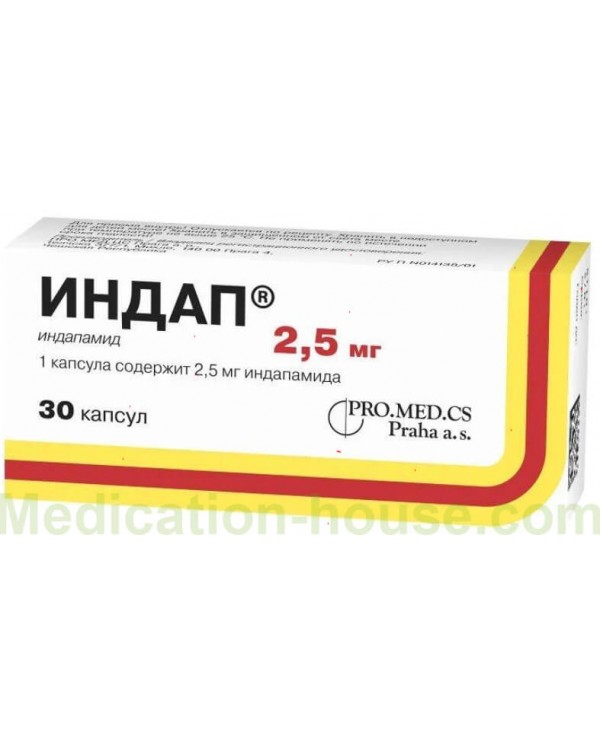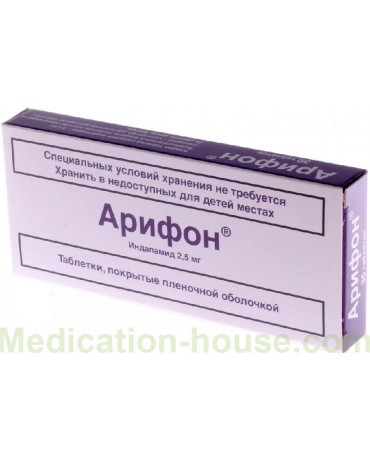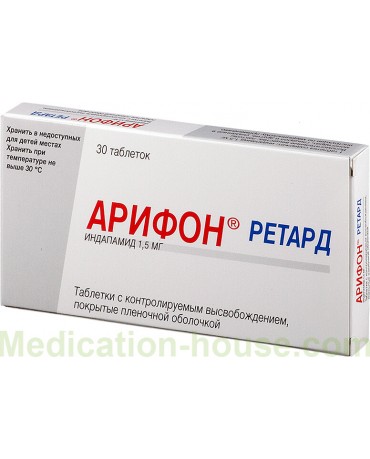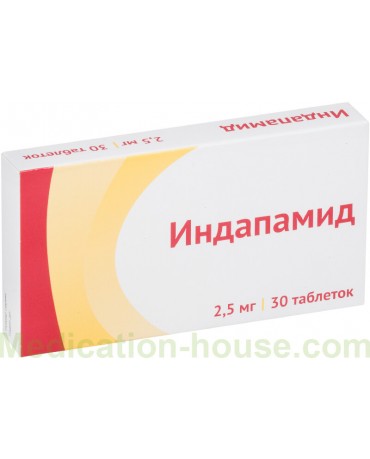Indap instruction
You can buy Indap here
Indap is an antihypertensive agent, a diuretic.
Release form and composition
Produced in capsules: size No. 4, hard gelatinous, with a blue cap and a white body; content - white or almost white powder (it can be a compressed column, disintegrating when pressed, or have pieces of mass in the composition) (10 pcs. in a blister, 3 blisters in a cardboard box).
Active ingredient: indapamide, in 1 capsule - 2.5 mg.
Auxiliary components: granular microcrystalline cellulose, colloidal silicon dioxide, magnesium stearate, titanium dioxide, corn starch, gelatin, lactose monohydrate, indigo carmine dye.
Indications for use
Indap is a drug for the treatment of arterial hypertension.
Contraindications for Indap
Absolute:
Hypokalemia;
Anuria, severe hepatic (including encephalopathy) and / or renal failure;
Acute violation of cerebral circulation;
Lactose intolerance, glucose / galactose malabsorption syndrome, galactosemia;
Simultaneous use of drugs that lengthen the QT interval;
Age under 18;
Pregnancy and lactation;
Hypersensitivity to drug components or other sulfonamide derivatives.
Relative (during the period of treatment with Indapom, the most careful monitoring of the patient's condition is necessary due to the risk of complications):
Decompensated diabetes mellitus;
Moderate renal and / or hepatic impairment;
Hyperparathyroidism
Cardiac ischemia;
Ascites;
Prolongation of the QT interval;
Chronic heart failure;
Hyperuricemia (especially if it is accompanied by urate nephrolithiasis and gout), hyponatremia, or other disorders of water and electrolyte metabolism.
Method of administration and dosage
Indap should be taken orally, in the morning, regardless of the meal, swallowing the whole capsule with plenty of water.
The standard daily dose of Indap is 2.5 mg (1 capsule).
If necessary, the drug can be used in combination with other antihypertensive drugs (angiotensin-converting enzyme inhibitors, slow calcium channel blockers, beta-blockers). If, after 4-8 weeks of treatment, the desired therapeutic effect cannot be achieved, it is advisable to add another antihypertensive drug that is not a diuretic. The dose of indapamide in this case remains unchanged - 2.5 mg once a day. It is inappropriate to increase the dose of Indap, since the risk of side effects increases without increasing the antihypertensive effect.
Side effects of Indap
From the side of the central nervous system: general weakness, malaise, lethargy, fatigue, vertigo, asthenia, tension, nervousness, irritability, headache, drowsiness or insomnia, lethargy, depression, agitation, anxiety, muscle spasm;
From the digestive system: abdominal discomfort, dry mouth, gastralgia, anorexia, constipation or diarrhea, nausea, vomiting, hepatic encephalopathy (in patients with hepatic insufficiency);
From the respiratory system: rhinitis; rarely - pharyngitis, cough, sinusitis;
From the urinary system: polyuria, nocturia, an increase in the incidence of infections;
From the side of the cardiovascular system: palpitations, arrhythmia, orthostatic hypotension, changes in the electrocardiogram (hypokalemia);
From the side of hematopoiesis: agranulocytosis, leukopenia, bone marrow aplasia, thrombocytopenia, hemolytic anemia;
From the senses: visual impairment, conjunctivitis;
Allergic reactions: rash, itching, urticaria, hemorrhagic vasculitis;
On the part of laboratory parameters: hyponatremia, hypochloremia, hyperglycemia, hyperuricemia, hypokalemia, hypercalcemia, hypomagnesemia, glucosuria, hypercreatininemia, increased plasma urea nitrogen;
Others: chest and back pain, flu-like syndrome, sweating, rhinorrhea, pancreatitis, exacerbation of systemic lupus erythematosus, weight loss, decreased potency and / or libido, paresthesia in the extremities.
Special instructions
Indap is effective in the treatment of high-risk patients with arterial hypertension, i.e. patients with concomitant pathology, for example, diabetes mellitus (mild or moderate), hyperlipidemia, chronic renal failure.
During therapy, the content of residual nitrogen and uric acid in the blood plasma should be regularly monitored.
During the first week of treatment, it is necessary to take the first measurement of the concentration of potassium in the blood.
With long-term treatment, the development of electrolyte metabolism disorders, such as hypercalcemia, hyponatremia, hypochloremic alkalosis, hypokalemia, is possible. These disorders are more likely to occur with diarrhea and vomiting, in patients with liver disease and chronic heart failure, in people on a salt-free diet. For this reason, during the period of therapy, the electrolyte composition of the blood should be monitored.
Patients with diabetes mellitus need to control blood glucose levels, especially in the presence of concomitant hypokalemia.
Patients receiving indapamide are likely to develop orthostatic hypotension, which can be triggered by the intake of other antihypertensive drugs, opioid analgesics, barbiturates, and alcohol.
Indapamide-induced hypokalemia may increase glycoside toxicity. For this reason, it is necessary to control the content of creatinine and potassium in the elderly, patients taking cardiac glycosides or laxatives, and in patients with hyperaldosteronism.
It should be borne in mind that hypercalcemia that developed during the period of Indap's use may be a consequence of previously undiagnosed hyperparathyroidism.
Significant dehydration during treatment can lead to the development of acute renal failure, therefore, at the beginning of therapy, it is necessary to compensate for the loss of water, the entire period of use of the drug - to monitor renal function.
In patients receiving indapamide, it is possible to obtain a positive result during doping control.
If it is necessary to prescribe angiotensin-converting enzyme inhibitors to patients with arterial hypertension and hyponatremia resulting from taking diuretics, Indap should be canceled 3 days before. A little later, the diuretic can be resumed.
Indapamide may worsen the course of systemic lupus erythematosus.
In patients with insulin-dependent diabetes mellitus, indapamide may increase the need for insulin. With latent diabetes mellitus, blood glucose levels should be monitored.
Drug interactions
Lithium preparations: the risk of developing the toxic effect of lithium increases (this combination is not recommended);
Astemizole, sultopride, pentamidine, vincamine, terfenadine, erythromycin (intravenous), antiarrhythmic drugs of class IA (quinidine, disopyramide) and III (bretilium, amiodarone, sotalol): the hypotensive effect of indapamide is weakened, the development of arrhythmias of the "pirouette" type is possible;
Glucocorticosteroids, non-steroidal anti-inflammatory drugs, adrenostimulants, tetracosactide: the hypotensive effect of indapamide decreases;
Baclofen: the antihypertensive effect of indapamide is enhanced;
Saluretics (loop, thiazide), gluco- and mineralocorticosteroids, laxatives, cardiac glycosides, amphotericin B (intravenous), tetracosactide: the risk of hypokalemia increases;
Cardiac glycosides: the likelihood of developing digitalis intoxication increases;
Metformin: possible aggravation of lactic acidosis;
Calcium supplements: the risk of developing hypercalcemia increases;
Potassium-sparing diuretics: the risk of developing hypo- or hyperkalemia increases, especially in patients with renal failure and diabetes mellitus;
Angiotensin-converting enzyme inhibitors: the risk of arterial hypotension and / or acute renal failure increases (especially in patients with renal artery stenosis);
Tricyclic antidepressants, antipsychotics: the antihypertensive effect of indapamide increases, the risk of orthostatic hypotension increases;
Cyclosporine: increases the level of creatinine in the blood plasma;
Non-depolarizing muscle relaxants: the blockade of neuromuscular transmission caused by them increases;
Indirect anticoagulants (coumarin or indandione derivatives): their effectiveness decreases;
Iodine-containing contrast agents in high doses (against the background of dehydration of the body): the risk of developing renal failure increases (before the introduction of these agents, it is necessary to restore the loss of fluid).
Terms and conditions of storage
Store at a temperature of 15-25 ºС in a place protected from light and moisture, out of the reach of children.
Shelf life is 3 years.
Terms of sell
You don't need a prescription to buy Indap.




